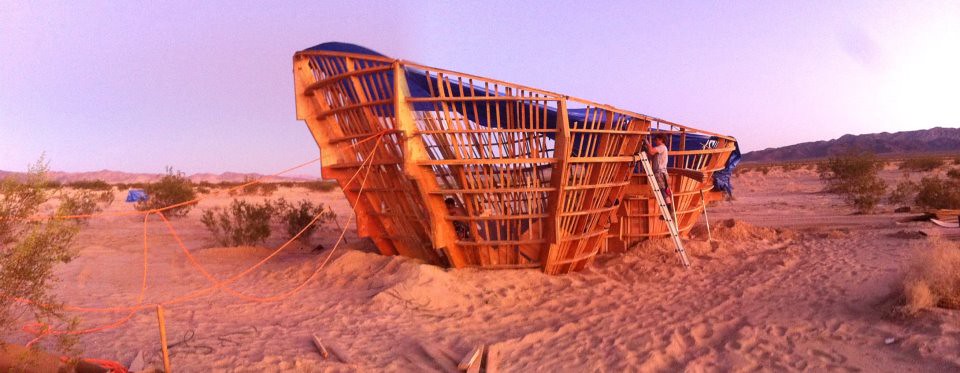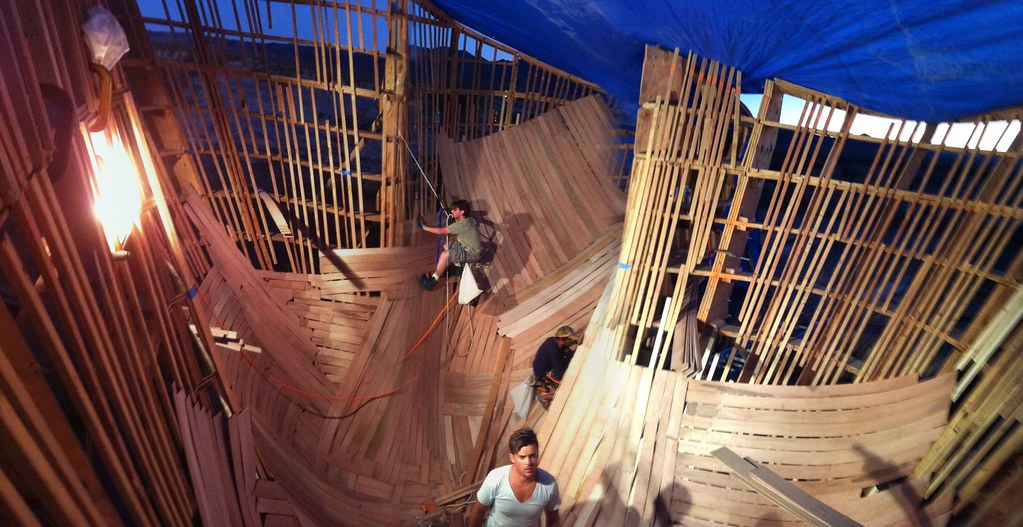"My mind tends to get very big when I’m out here. I don’t mean egotistical, but the expansive space makes most of my thoughts seem pretty insignificant. This is supported by a long sense of time; a sense of slow time." - Ball-Nogues Studio

High Desert Test Sites is this upcoming weekend! One project I'm looking forward to seeing in person in Ball-Nogues' Yucca Crater. Their work has quickly altered our definitions of current architecture and art, as well as the California landscape. Sunday afternoon, they will be having a pig roast at the Yucca Crater, open to all who are out in the desert roaming the dusty trails, looking at the works of this years' HDTS designers + artists. - David John
Ball-Nogues Studio explores the nexus of art, architecture, and industrial design. As an integrated design and fabrication practices, they create experimental environments to enhance and celebrate the potential for social interaction through sensation, spectacle, and physical engagement. To achieve these results, they work with unusual materials, develop new digital tools, and apply architectural techniques in unorthodox ways.
The partners share an enthusiasm for the fabrication process as it relates to the built object both physically and poetically—they let the properties, limitations, and economic scenarios associated with a material guide a structure’s ultimate form while developing methods to extend the intertwined boundaries of a material’s aesthetics, physical potential and lifecycle.

Describe your project for HDTS 2011, and where is it located? Is there a narrative driving this work? Material Selection?
Located on Iron Age Road east of the town of Joshua Tree, Yucca Crater is a synthetic earthwork that doubles as a recreational amenity. This monumental basin stands 30 feet from rim to low point. Rock climbing holds mounted on the interior allow visitors to descend into a deep pool of water.
Yucca Crater expands on concepts borrowed from land art, incorporating the prospect of the abandoned suburban swimming pools scattered across the Mojave. Ball-Nogues has re-imagined these interventions in the landscape through a method of production where the tools of fabrication transform to be become objects for display in their own right. The plywood structure of Yucca Crater was originally the formwork used to construct another Ball-Nogues work, Talus Dome, in which more than 900 boulder-sized polished metal spheres were assembled to appear as a monumental pile of gravel. The two projects were “cross-designed” such that the method of production used in the first (Talus Dome) has become the central aesthetic for the second (Yucca Crater).
This approach integrates concept, aesthetics, and production, inviting viewers to reconsider their relationship to art by-products while repositioning them within an alternative economic and geographic domain.
Is your work for HDTS site-specific, and if so, how does it relate to the space of the desert? How would you personally describe High Desert/Mojave area?
We were riffing on other artworks that have been produced in the deserts of the American West. Yucca Crater is a synthetic earthwork. It is constructed of manmade materials but assumes the form of a feature we understand as being landscape. We set it into the earth 10 feet to make it feel like it is supposed to be there and so it will hold water.
My mind tends to get very big when I’m out here. I don’t mean egotistical, but the expansive space makes most of my thoughts seem pretty insignificant. This is supported by a long sense of time; a sense of slow time.

Is your work a permanent installation? And if so, how will it change with time?
Yucca Crater is permanent insofar as we will not be removing it from the site; it is intended to remain on Iron Age Road. It will be subject to entropy and eventually will be consumed by the landscape. I imagine it will become a bit like one of the ramshackle remains of one of those homestead houses dotting Yucca Valley, perhaps a bit more mysterious since nobody in the future will know what purpose it served.
How does your HDTS project relate to your ongoing practice as designers?
Aesthetics aside, the work is part of an ongoing investigation into something that might be called “cross design,” where we develop two projects simultaneously –where the production used in the first project becomes the central aesthetic for the second.
We hope that the community will use it over the HDTS weekend. It is kind of an earthwork but it is also kind of an outdoor playground. It caters to our culture of convenience: although twenty miles outside the nearest town, 29 Palms, you don’t need to pilgrimage too deep into the desert to visit an earthwork or find a climbing rock, you can do it all here at Yucca Crater, just off the road!
Future projects?
A public sculpture in Edmonton Alberta entitled Talus Dome – briefly described above. An artwork for the new Bradley West Terminal of Los International Airport entitled Air Garden. An installation in the gallery at the Southern California Institute of Architecture. We hope to use the cross design approach here – the project will be an architectural space constructed of Shaker inspired chairs, each one unique, that come apart at the end of the installation to form an immense dining room set. Two public artworks in the City of West Hollywood. Hopefully time off will become a project; we just haven’t found the time.
go to Ball-Nogues Studio here...
"Benjamin Ball and Gaston Nogues explore the nexus of art, architecture, and industrial design. Their work has been exhibited at major institutions throughout the world, including the Museum of Contemporary Art, Los Angeles; the Museum of Modern Art, New York; the Guggenheim Museum; PS1; the Los Angeles County Museum of Art; arc en rêve centre d'architecture + Musée d'Art Contemporain de Bordeaux; the Venice Biennale, the Hong Kong | Shenzhen Biennale; and the Beijing Biennale.
--------------------
